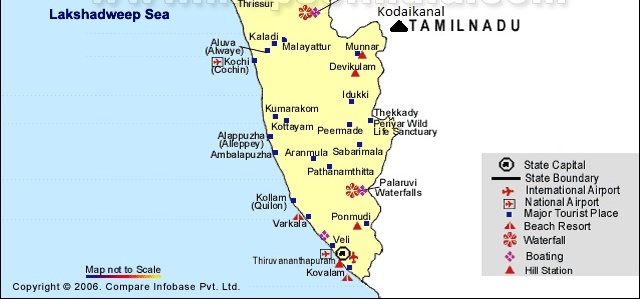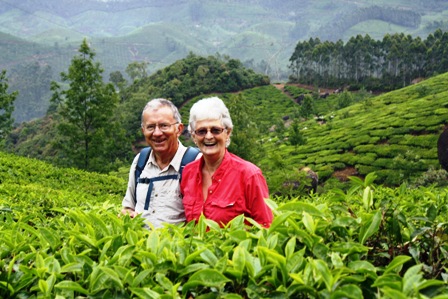Southern India Revisited
Episode 6: Munnar Tea Plantations

Click the photo above Munnar to see an album of photos. Close the window to return to this page
Previous: Episode 5: Shared Taxi to Munnar Next: Episode 7: Benaulim|
February 13-14 2013 Exploring Tea Plantations in Munnar We have visited tea plantations in at least four countries and I can honestly say that Munnar has the most extensive plantations we have seen. The tea industry was started by the British in Munnar in the 1880s. Forested hills were cleared and tea bushes established, creating some of the highest grown tea in the world. The tea industry was turned over to Indian companies in 1947 when the British left. The largest, if not the sole owner is now Tata, who also manufactures the vast majority of cars, trucks and buses in India. Our guesthouse, Green View Inn, was in the backpacker area of Munnar, about 2 km from the center of town. That meant we were surrounded by lush carpets of tea. Feeling considerably better after a good sleep and a small breakfast, we went for a short walk in the afternoon to take photos of the tea plantations. Kids were coming home from school packed like sardines in tuk-tuks, all waving and calling to us as they passed. We went past plantation workers huts, a school and hospital for the workers and a small Hindu temple painted in bright colours. A blue coloured deity on a white horse, scimitar raised high above his head, looked ready to smite a poised cobra below the horse. The short walk just left us wanting to explore more of the area. You can walk on the roads by yourself but if you want to really get into the plantations, you must go with a guide. Our chance came early the next morning. We joined nine other tourists; 2 fellows from Germany, 2 more from Denmark, a couple from Belgium, and an American man at 6:30 AM. We set off for a five hour walk with, Baboo, our guide.
We started off walking a short way out of town, past a dam, started in 1935 by the laying of the first stone by the local Maharaja, whose name took up fully three lines on the large board sign. The dam, finished in 1944, was the first Hydro Electric project in Kerala. We spent the next two hours climbing ever upward on paths through the tea plantations, stopping frequently for Baboo and the mountains stretching out into the distance in all directions. Just after 8 AM a line of tea plantation workers came up the path behind us. The women were going to pick for the day. Baboo said they only pick every 14 or15 days at this time of year. When the temperature is warmer in late March-April the leaves grow more quickly and they pick more frequently. The morning started out overcast and cleared for a while before black clouds started to gather as we climbed higher. By the time we reached our Breakfast spot, on a large flat rock at 1700m, the Kerala Mist was upon us, and the wind was blowing. We put on our rain jackets but the rain soon stopped. Baboo had carried up our breakfast of toast and jam, hard boiled eggs, cut pineapple, watermelon and bananas, plus tea in a thermos. It was just what we needed. The route down was mostly on roads past two rickety wooden tree houses used by workers and a few upscale resorts in the plantations. We stopped to see coffee bushes and passed through one of many cardamom plantations, another important crop in the region. Besides being a favourite ingredient in various curries and sauces, it adds a delicious flavour to a cup of tea or coffee. Before we knew it, we were back at Green View just before noon. Later in the afternoon we walked into the town of Munnar, keeping out of the way of buses, trucks, cars, motorcycles and tuk-tuks all manoeuvring around potholes on the narrow road. We arrived in the middle of a busy bazaar area of small shops. Munnar is a commercial center for the tea industry and has not bothered to clean itself up for the tourist trade. We made the right decision to stay in the much quieter backpacker suburb. We stayed long enough to walk through the bazaar area and take photos of the three main religious buildings; a Catholic Church, a Mosque and a Hindu temple. I thought the small tea workers temple near our guesthouse was more interesting than the town temple. We took a tuk-tuk back to Green View for Rs30, had tea on the terrace next to our room and organized photos of Munnar. We certainly could stay longer in Munnar, take a few more hikes and maybe just veg out in one of the cabins in the midst of the tea plantations. Instead, we are taking a bus to Cochin airport tomorrow, staying overnight at an airport hotel, before flying to Goa on Saturday morning. |
Previous: Episode 5: Shared Taxi to Munnar Next: Episode 7: Benaulim
Read Sri Lanka 2013
Return to India 2013 Intro
Return to India Chronicles 2000-2001
Return to Travels
or Introduction
